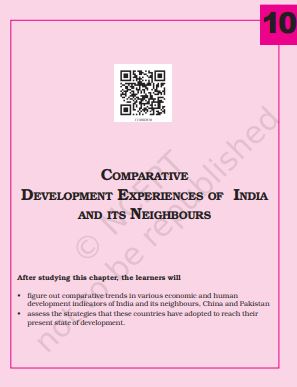‘NCERT Solutions for Class 11 Economics Chapter 10 Comparative development Experiences Of India and Its Neighbors‘ PDF Quick download link is given at the bottom of this article. You can see the PDF demo, size of the PDF, page numbers, and direct download Free PDF of ‘Ncert Class 11 Economics Chapter 10 Exercise Solution’ using the download button.
Comparative Development Experiences Of India and Its Neighbors Book PDF Free Download

Chapter 10: Comparative development Experiences Of India and Its Neighbors
In the preceding units, we studied the developmental experience of India in detail. We also studied the kind of policies India adopted, which had varying impacts in different sectors.
Over the last two decades or so, the economic transformation that is taking place in different countries across the world, partly because of the process of globalization, has both short as well as long-term implications for each country, including India.
Nations have been primarily trying to adopt various means which will strengthen their own domestic economies.
To this effect, they are forming regional and global economic groupings such as the SAARC, European Union, ASEAN, G-8, G-20, BRICS, etc.
In addition, there is also an increasing eagerness on the parts of various nations to try and understand the developmental processes pursued by their neighboring nations as it allows them to better comprehend their own strengths and weaknesses vis-à-vis their neighbors.
In the unfolding process of globalization, this is particularly considered essential by developing countries as they face competition not only from developed nations but also amongst themselves in the relatively limited economic space enjoyed by the developing world.
Besides, an understanding of the other economies in our neighborhood is also required as all major common economic activities in the region impinge on overall human development in a shared environment.
In this chapter, we will compare the developmental strategies pursued by India and the largest two of its neighboring economies Pakistan and China.
It has to be remembered that despite being endowed with vast natural resources, there is little similarity between the political power setup of India.
the largest democracy of the world which is wedded to a secular and deeply liberal Constitution for more than half a century, and the militarist political power structure of Pakistan or the command economy of China that has only recently started moving toward a democratic system and more liberal economic restructuring respectively.
10.2 Developmental Path: A Snapshot View
Do you know that India, Pakistan, and China have many similarities in their developmental strategies? All three nations have started on their developmental path at the same time.
While India and Pakistan became independent nations in 1947, the People’s Republic of China was established in 1949.
In a speech at that time, Jawaharlal Nehru said, “These new and revolutionary changes in China and India, even though they differ in content, symbolize the new spirit of Asia and new vitality which is finding expression in the countries in Asia.” All three countries had started planning their development strategies in similar ways.
While India announced its first Five Year Plan for 1951–56, Pakistan announced its first five-year plan, now called the Medium Term Development Plan, in 1956. China announced its First Five Year Plan in 1953.
Since 2018, Pakistan is working on the basis of the 12th Five Year Development Plan (2018–23), whereas, China is working on 14th Five Year Plan (2021–25).
Until March 2017, India has been following the Five Year Plan-based development model. India and Pakistan adopted similar strategies, such as creating a large public sector and raising public expenditure on social development.
Till the 1980s, all three countries had similar growth rates and per capita incomes. Where do they stand today in comparison to one another?
Before we answer this question, let us trace the historical path of developmental policies in China and Pakistan. After studying the last three units, we already know what policies India has been adopting since its Independence.
| Author | NCERT |
| Language | English |
| No. of Pages | 28 |
| PDF Size | 2.6 MB |
| Category | Economics |
| Source/Credits | ncert.nic.in |
NCERT Solutions Class 11 Economics Chapter 10 Comparative development Experiences Of India and Its Neighbors
1. Why are regional and economic groupings formed?
Regional and economic groupings were formed by countries to understand the development strategies and growth measures that are used by the other member countries.
This helped countries to analyze the strength and weaknesses they possessed and the corrective measures that need to be taken for bringing growth and prosperity. Forming a regional group also makes countries maintain peace among themselves and have a common platform for trade as well as a representation in the world forums.
2. What are the various means by which countries are trying to strengthen their own domestic economies?
The following means by which countries are trying to strengthen their own domestic economy are:
1. By forming regional and economic groupings like European Union (EU), SAARC, ASEAN, OPEC, and G-8 etc.
2. By analyzing the development model and strategies adopted by member countries in order to boost the economy of the country.
3. By liberalizing the economies which reduces government intervention in economic activities, the economy is governed by demand and supply of the market.
4. By opening their economy to the world which is known as globalization. It is a move to provide the scope of business in the international market for domestic products.
3. What similar developmental strategies have India and Pakistan followed for their respective developmental paths?
The following developmental strategies were followed by India and Pakistan:
1. Developmental programs adopted by both countries were based on economic planning.
2. For growth and development public sector was selected as the medium of choice.
3. A mixed economic structure was followed by both countries which involved public and private sector participation.
4. Economic reforms were introduced at the same time to strengthen their respective economies.
4. Explain the Great Leap Forward campaign of China as initiated in 1958.
Great Leap Forward was a campaign started by communist leader Mao Zedong in 1958. It had the following objectives:
1. To initiate industrialisation of the economy in urban as well as rural areas.
2. Motivating people to setup industries in backyard
3. Engaging rural people in collective farming under the Commune System.
Related PDFs
अर्थशास्त्र वस्तुनिष्ठ प्रश्न और उत्तर PDF In Hindi
NCERT Class 11 Economics Textbook Chapter 10 With Answer PDF Free Download
